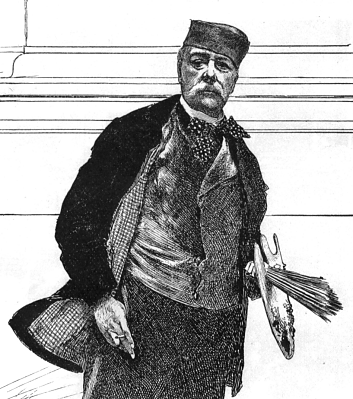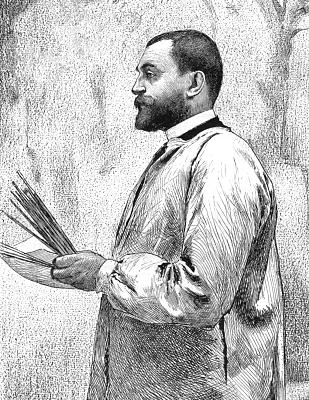THE PARIS PANORAMA OF THE NINETEENTH CENTURY
By Theodore Stanton, 1889.

Alfred Stevens
|
|
THE ARTISTS. One of the attractions of Paris during
the International Exhibition was the Panorama of the Nineteenth Century, the production of
two talented artists, Alfred Stevens and Henri Gervex.
Those in France best qualified to judge of such a production are unanimous in their
opinion that it rises far above the general average of work of that class. Instead of
merely putting on canvas, as is too often the case, confused masses of fanciful
personages, the two artists have taken the trouble to paint life-like portraits of a
thousand or more of the most illustrious men in French history, from 1789 down to the
present year.
Alfred Stevens and Henri Gervex, the authors of the panorama and of the following
article, are not unknown in America. Alfred Stevens is the elder. He was born in Belgium
in 1830, and was the pupil of Navez, at Brussels. He came to Paris when only seventeen to
work in Camille Roqueplan’s studio and perfect himself in the technique of his art.
Since then he has never left the French capital. By the time he attained his twenty-fifth
year he was the object of considerable attention on the part of artists and connoisseurs;
but the turning-point in his career may be said to date from the Paris International
Exhibition of 1867, to which he contributed no fewer than |
eighteen paintings in oil-colors, some of which at once
placed the young artist in the foremost rank of living painters. Ten years later Alfred
Stevens exhibited “The Seasons,” four panels that were purchased by the King of
the Belgians, and seven other great paintings. More recently he contributed to the world
of art several well-known canvases, which greatly increased his reputation. While he takes
rank among the best modern painters, he is also one of the most prolific.
Mr. Stevens is much above medium height, of commanding presence and
vigorous frame, with a heavy gray mustache, which gives him a military air. His features
are regular and evince great force of character. He holds a high position in the social
world of Paris, and may lay claim to a favor rarely accorded to living men by the city
fathers, that of having a street named after him.
Mr. Gervex is twenty-five years younger than
his colleague, whose pupil he was formerly, and of whom some years ago he painted a most
striking portrait. He was born in Savoy, at the foot of Mont Blanc, but he also came to
Paris at a very early age, and began painting at fifteen, under the guidance of M.
Brisset. Later he followed the lessons of Fromentin and Cabanel. His d but at the Salon
dates from 1872, when he sent a study after the nude which was purchased by the state.
Another work, “Diana and Endymion,” sent the following year, was the object of
considerable notice at the time; it figures to-day at the Luxembourg. |
|

Henry Gervex
|
Unshackled by the prejudices of the ultra classical
school, the young artist gave himself up entirely to the study of nature. He, too, desired
to be “modern.” All his more recent pictures bear the impress of that aim, as
shown by “The Girl Communicants at the Church of the Trinit ,”
“Rolla,” and “Home from the Ball.”
In 1879 Mr. Gervex exhibited some cartoons for the decoration of one of the Paris mairies
(mayoralty houses), and secured the order from the municipality over the heads of three
hundred competitors. His subject was “Civil Marriage,” and it ranks high as a
work of art in the estimation of all connoisseurs. Among other of his works deserving of
attention we may instance: “A Sitting of the Jury at the Salon of Painting”,
“After a Masked Ball, at Six in the Morning,” “The Woman with the
Mask,” and “Dr. P an at the Saint Louis Hospital.” His pastel portraits of
John Lemoinne, the Prince de Sagan, Guy de Maupassant, and of some very pretty feminine
heads, the Comtesse de Montebello, the Baronne de Heeckeren, and others, have attracted
considerable attention.
Mr. Gervex is of medium height, with a pleasant and refined
countenance. He is clever at repartee, full of merriment, and is a general favorite in
society. |
|

The Panoraman Building on the Champs-Elys es

|
|